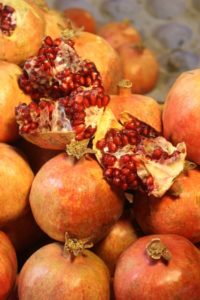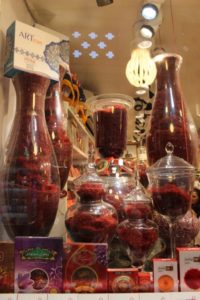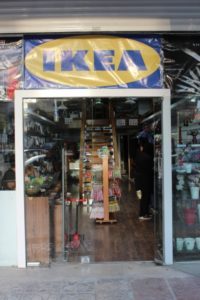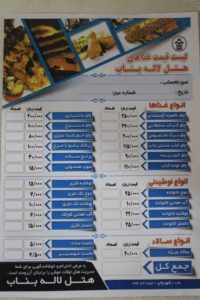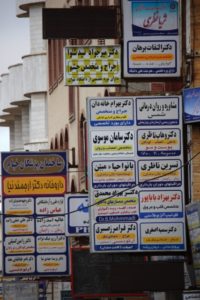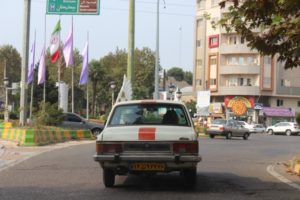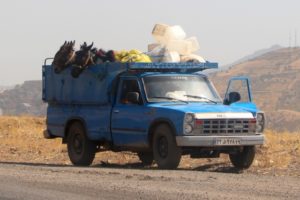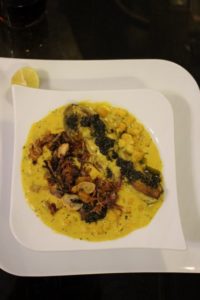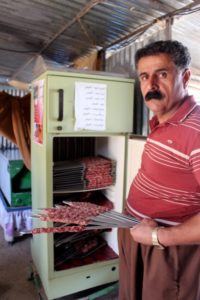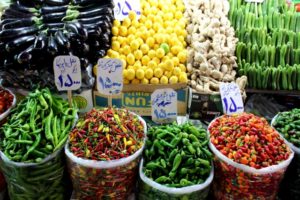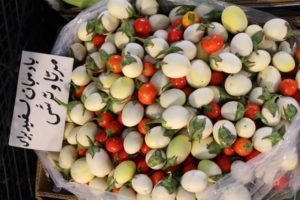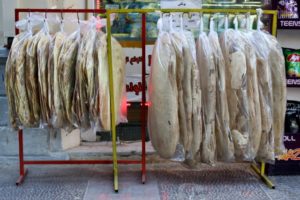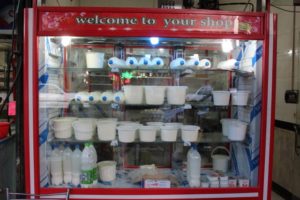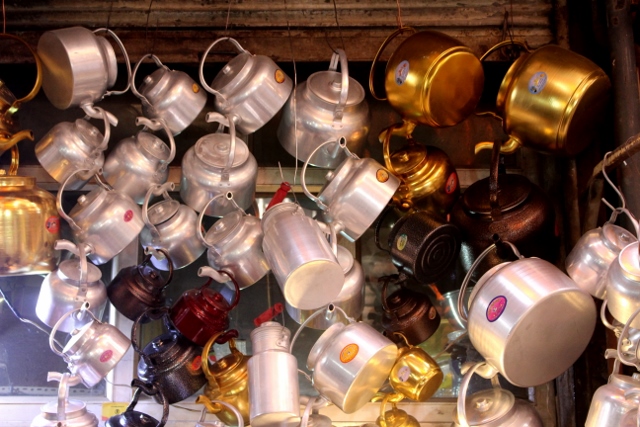Some tips and tricks for traveling in Iran
Iran is pretty unknown for most travellers, so much is clear, yet, many people I talk to after our trip are very interested. And they have lots of questions about the actual process of traveling in this country: is it safe, is there public transport, is it difficult to find hotels, restaurants? There are plenty of blogs on the Internet, and there are the guide books, which give plenty of information on traveling in Iran. But some people will experience certain things differently from others. So below I have captured some of what I call the more mundane issues of traveling in Iran, to help future travellers get an impression of what to expect. Of course, they are just my own impressions, which someone else may have interpreted totally differently.
Culture: Of hospitality and tara’of.
There are probably no more hospitable people in the world than the Iranians. They will strike up a conversation, even if they don’t speak anything else than Farsi. A fair bet is that their first question is “where are you from?”, so even if you don’t understand the question, the answer should be easy. Often this is followed by “welcom in Iran (or in the city where you are)”, and they mean this, genuinely. The conversation may stop here, or may continue, with the suggestion to come and drink tea at their house, have dinner, anything. And this is where it becomes tricky, because you are entering the wasp nest of tara’of. Iranians will always invite you, but not necessarily mean it, and thus maybe highly embarrassed when you accept the invitation. But then again, they may mean it. Point is that from that moment onwards you are their guest, and they will insist on paying everything, which for us Westerners can become very uncomfortable – because we don’t want to abuse the hospitality. They will also insist on taking you everywhere, and it may be difficult to disengage yourself again. Having said all this, Iranians are generally very pleasant company, and a certain fear for overindulgence should not get in the way of genuinely exploring human contact, something that in Iran can be very rewarding, for both sides: Iranians are very interested in how the West works and lives and thinks, and they expect you to be quite honest – without being rude – in your answers to their many questions.
We carried a bag full of small souvenirs from home, as well as large boxes of chocolates, to give away as a token of appreciation when we once again failed to pay anything. Works well, and is well appreciated.
Dress code: Of headscarves and shorts:
You just need to accept that in Iran you cannot go around as you wish. Most Iranians are fairly well dressed, in Tehran you find the newest fashion, whilst in the country side, and smaller towns, the cloths maybe a little more old-fashioned. Best is, for your own comfort, to try to fit in. Men don’t go around in shorts, in a country where women are forbidden to watch a football match, because of all these half-naked men’s legs. And women, well, just have to cover their head when outside the home, or hotel room, essentially when you are running the risk meeting a non-family male. That doesn’t mean you need a burka, or a chador, for full coverage, but you cannot show too much skin, you cannot wear tight-fitting cloths, and you must cover your hair. Now there are ways and ways to cover your hair, and in Tehran many young women are testing the water, with hijabs (headscarves) at the very edge of their hairclip, but again, outside Tehran life is more conservative. You can argue the issue until the cows come home (and whether this is what women want or not: the reality is that some do, others don’t), but in the end it is the law, like it or not. Buy cotton headscarves, they are much cooler than anything with the faintest amount of nylon in it.
Money: Of cash, and nothing but cash.
The Iranian finance system is still very much shut off from the international payment circuit. Foreign credit cards don’t work, neither do any of the foreign cards to draw money from a machine (which is a shame, because payment by card – local card – is widespread in Iran). So bring cash, enough to pay for all your local expenses, and a little extra for emergencies. Most large town have exchange offices, which give a much better exchange rate than the banks, and are much quicker, too. US$ or Euros most commonly accepted by these offices.
Once you have changed money, you are quickly a millionaire, in Rials, the local currency. But most Iranians think in Toman, 10 Rials being 1 Toman, even though Tomans do not exist, there are no coins or banknotes in Tomans. Takes a while to get used to, but you will, eventually.
NEW: After our return from Iran I was made aware of the existence of MahCard, a prepaid debit card apparently widely accepted in Iran. I haven’t used it myself, so I cannot vouch for it, but it looks like an interesting alternative. Check out for yourself on their site, https://www.mahcard.com/. Oh, and be prepared to call out your pin number to the local sales person to whom you have just handed your card, whilst the rest of the customers are listening, too. There is nothing strange about this, in Iran, and it works perfectly OK.
Language:
They speak Farsi, in Iran, which is quite different from our Western languages. What is worse, they also write in Farsi, which has its own script, completely unintelligible for the average Westerner. On top of that, they write from right to left – except if they write numbers, then it goes from left to right. Numbers is not too difficult to learn, though.
The good news is that almost always, right when you need them, somebody will turn up who speaks a bit of English, to ask whether he or she can help.
Travel: Of buses, trains and taxis.
Iran is a quite developed country. There is an excellent bus system connecting most cities – and if your destination is not connected by direct bus, people will tell you where to go to change buses. Long distance there are VIP buses, very comfortable, with spacious, reclining seats, and biscuits and drinks provided. And also cheaper, less luxurious buses, without biscuits and with less leg space. VIP or not, they do not often stop for intermediate toilet breaks, though, but they stop for lunch. One hitch is that if you want to get off before the final destination of the bus, you often still need to pay the full price – which is, however, never very expensive.
There are also trains, between certain towns, a very comfortable way of transport. But it is not necessarily easy to get tickets, and a travel agency is often a better bet than the station itself. And frequency is much less than the buses, with departure times often not the most convenient. For long distances, the overnight sleepers are a good alternative. Of course, you can also fly, relatively cheaply, but again, you depend on the flight schedules. Once again, best bet is a travel agent – who will level some commission, of course
Buses, trains (I think), and planes can be booked online, too (this is a developed country, I told you), but websites are in Farsi, and payment methods only by local card, international cards are not recognised in Iran. So you need a Farsi speaker who can also pay for you – some hotels will help you, if you ask. And some bus reservations can be made online, with payment in cash later at the terminal.
An alternative for shorter distances, say, two hours or less, are the savaris, or shared taxis, which congregate in certain places in town (your hotel, or any taxi driver, will know where, for which destination); they leave when full, which means four people. Sometimes the front seat is slightly more expensive than one of the three back seats, but then, if you travel as a couple, you may be shifted around when somebody from the other sex enters, as women will not normally be seated next to unrelated men (same on the bus). Savaris are also not very expensive. You can also agree “dar bast” with the savari driver, which literally means with closed doors, in other words, the whole car for yourself: you just need to pay for all the seats.
In town, taxis are the easiest option, seldom cost more than the equivalent of 1-2 US$ (except in Tehran, where they are a little more expensive, in the order of 5-7 US$ depending on distance). Taxis are not necessarily recognisable as such: lots of clearly marked yellow or green cars, but also completely unmarked cars will stop if you raise your arm, or if you are just looking lost along the side of the road. Some are indeed taxis, others are not, but their drivers will happily earn a little on the side. They charge the same as taxis. Oh, and tara’of plays a role, too, initially many taxi drivers will refuse payment, which does NOT mean that you should get out without paying, you just need to insist a little harder. Such is customs in Iran.
Tehran has a well-functioning metro, as well as the Rapid Transit System, which means buses that have a dedicated lanes, bypassing most of the traffic jams. The buses (and the metro, too, at times) may get jammed themselves, though – they can get pretty busy. On the town buses, women are expected to enter at the back, where there is a separate female section; the metro has the same, but less strictly enforced. RTSs are operational in some other cities, too, like Tabriz. You buy your RTS tickets outside the bus, in ticket boots near major stops (not always very clearly sign posted, just ask).
Hotels:
In most towns you will find one or more mid-class hotels, in the range of 30-50 US$, with varying room quality. We had mostly good experiences, clean, comfortable, private bathroom with, in most cases, a Western toilet (although many hotels will also have rooms with squat toilet). You can go cheaper, or more expensive, and quality will vary accordingly. That said, quite a few mid-class hotels charge up to 100 US$, without offering anything more than their more economic brethren, so it pays to shop around – if you can: in smaller towns hotels are not necessarily plenty. Negotiating prices down only worked a few times. Almost everywhere quite reasonable internet is available, if not in the room, then at least in the lobby.
Food & drink: Of kebabs and pizza, and the non-alcoholic aperitive.
My favourite subject! Iranian food can be very tasty, and varied. Home-cooked meals, of which we sampled a few, are generally excellent, stews of meat and vegetables, often including beans. Outside the homes, restaurants quickly revert to kebabs, and more kebabs, usually chicken or minced meat. Which is very nice, served with rice or flat bread, a roasted tomato, very acid pickles and quite often fresh herbs like parsley, coriander, mint and/or basil (called ‘vegetables’ or ‘mountain vegetables’). It is just that after a while you want something else. The occasional traditional restaurant, often large, for some reason often unfriendly, and often overpriced, serves a wider menu than kebabs, including vegetable (=bean) stews, eggplant dishes and fesejun, chicken or something else with a walnut and pomegranate sauce. Despite the bazaars being full of many more fresh vegetables, they do not seem to enter the restaurant menus. The alternative is fresh salad, often available in pre-packed plastic dishes, but quite OK (be careful with the dressings, though, they may not be your taste).
Most popular are the fast food restaurants, serving hamburgers and/or pizzas. But Iranians don’t know about hamburgers, here they are just flat, overcooked and tasteless frisbies, served with lots of lettuce and acid pickles in an oversized sandwich – not my favourite. And pizzas: slightly better, but they don’t resemble anything close to the Italian (or New York) version; cheese is often a rather mild white feta-type of cheese, and although Iranians eat tomatoes with almost everything else, curiously, they don’t put them on a pizza. Never. Yet, a pizza might be an alternative if you are fed up with kebabs.
Another possibility may be to shop for fresh fruit in the market, and with fresh bread or cheese, or fresh dates (in October, harvest season) munch this in your hotel room, quite a filling meal. Fruit is really excellent, here, whether melons or peaches, delicious small, very sweet pitless grapes, apricots, pears, you name it and it exists – in season.
A word on breakfast: don’t expect too much. All that delicious fruit is not served with breakfast. Instead, the standard is flat bread with packaged cream cheese, or in the better versions, real white cheese, a plastic cup of jam and/or honey, and with luck sliced tomatoes and cucumbers. Top locations have boiled eggs, and occasionally somebody will serve fried eggs or omelette. And the bread? Really nice, often served in a plastic bag or to be taken from a large plastic container, but in open air it gets hard while you are looking at it, and then it becomes almost inedible.
In between your meals, there is bastani, the Farsi word for ice cream. Varies from excellent quality to pretty chemical, which you can often tell from the colour. In the better ice cream parlours, they mix vanilla ice cream with carrot juice – try it, it is excellent! Many ice cream shops also have fruit blenders, which serve melon juice, or banana, or peach, or a kind of mix milkshake. Great alternative for a gin-and-tonic in the late afternoon. Because gin-and-tonic is not available (no gin, neither tonic). And no other alcoholic beverage either (although, if you cosy up to the right Iranians, you may be offered some kind of moonshine liquor – which is best avoided, not only to stay out of trouble with the authorities, but also in order to protect your eyesight).
The drink of choice in Iran is tea, served everywhere, often even without asking. Except in restaurants, where one assumes that you will have a soft drink, Coca Cola or Sprite or Fanta (or, sometimes, a cheeky look-alike). Or an alcohol-free beer, with peach or lemon taste, not my favourite. There is also doogh, a sour yogurt drink, very refreshing. And water, in small (500 cc) and large (1500 cc) bottles (although tap water is, in most places, perfectly potable, if not always tasty).
Whatever you order, everything is between cheap and very cheap, compared to Western prices.
